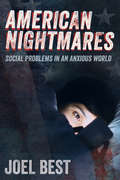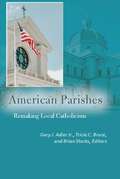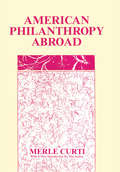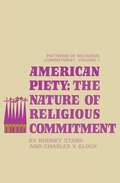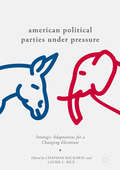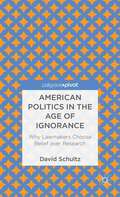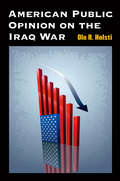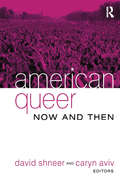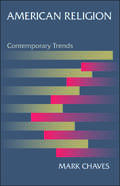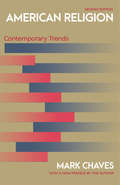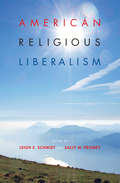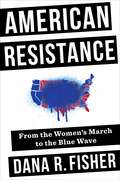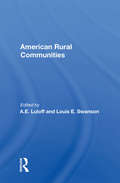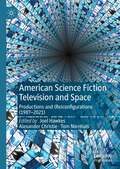- Table View
- List View
American Nightmares: Social Problems in an Anxious World
by Joel BestIn an accessible and droll style, well-known sociologist Joel Best shines a light on how we navigate these anxious, insecure social times. While most of us still strive for the American Dream—to graduate from college, own a home, work toward early retirement—recent generations have been told that the next generation will not be able to achieve these goals, that things are getting—or are on the verge of getting—worse. In American Nightmares, Best addresses the apprehension that we face every day as we are bombarded with threats that the social institutions we count on are imperiled. Our schools are failing to teach our kids. Healthcare may soon be harder to obtain. We can’t bank on our retirement plans. And our homes—still the largest chunk of most people’s net worth—may lose much of their value. Our very way of life is being threatened! Or is it? With a steady voice and keen focus, Best examines how a culture develops fears and fantasies and how these visions are created and recreated in every generation. By dismantling current ideas about the future, collective memory, and sociology’s marginalization in the public square, Best sheds light on how social problems—and our anxiety about them—are socially constructed.
American Parishes: Remaking Local Catholicism (Catholic Practice in North America)
by Gary J. Adler Jr., Tricia C. Bruce, and Brian StarksParishes are the missing middle in studies of American Catholicism. Between individual Catholics and a global institution, the thousands of local parishes are where Catholicism gets remade. American Parishes showcases what social forces shape parishes, what parishes do, how they do it, and what this says about the future of Catholicism in the United States. Expounding an embedded field approach, this book displays the numerous forces currently reshaping American parishes. It draws from sociology of religion, culture, organizations, and race to illuminate basic parish processes, like leadership and education, and ongoing parish struggles like conflict and multiculturalism. American Parishes brings together contemporary data, methods, and questions to establish a sociological re-engagement with Catholic parishes and a Catholic re-engagement with sociological analysis. Contributions by leading social scientists highlight how community, geography, and authority intersect within parishes. It illuminates and analyzes how growing racial diversity, an aging religious population, and neighborhood change affect the inner workings of parishes. Contributors: Gary J. Adler Jr., Nancy Ammerman, Mary Jo Bane, Tricia C. Bruce, John A. Coleman, S.J., Kathleen Garces-Foley, Mary Gray, Brett Hoover, Courtney Ann Irby, Tia Noelle Pratt, and Brian Starks
American Philanthropy Abroad
by Merle CurtiThis book tells for the first time, in rich detail, and without apologetics, what Americans have done, in the voluntary sector and often without official sanction, for human welfare in all parts of the world. Beneath the currently fashionable rhetoric of anti-colonialism is the story of people who have aided victims of natural disasters such as famines and earthquakes, and what they contributed to such agencies of cultural and social life as libraries, schools, and colleges.The work of an assortment of individuals, from missionaries to foundation executives, has advanced public health, international education, and technical assistance to the Third World. These people have also assisted in relief and relocation of refugees, displaced persons, and those who suffered religious and racial persecution. These activities were especially noteworthy following the two world wars of the twentieth century.The United States established great foundations—Carnegie, Rosenwald, Phelps-Stokes, Rockefeller, Ford, among others—which provided another face of capitalist accumulation to those in backward economic regions and those suffering political persecution. These were meshed with religious relief agencies of all denominations that also contributed to make possible what Arnold Toynbee called “a century in which civilized man made the benefits of progress available to all mankind.” This is a massive work requiring more than five years of research, drawing upon a wide array of hitherto unavailable materials and source documents.
American Piety: The Nature of Religious Commitment
by Rodney Stark Charles Y. GlockHow religious are Americans these days? How many still believe in God, in Biblical miracles, in heaven and hell? Do people pray? How much money is being given to churches, by Episcopalians, Presbyterians, Roman Catholics, Lutherans, and other groups? American Piety, the first of a three-volume study of religious commitment, answers these and a host of other questions about the contemporary religious scene. Particularly startling are the contrasts in beliefs, practices, and experiences revealed among the eleven major Christian denominations whose membership is compared.
American Political Parties Under Pressure: Strategic Adaptations for a Changing Electorate
by Chapman Rackaway Laurie L. RiceThis book addresses the changing electoral and political circumstances in which American political parties found themselves during the 2016 election, and the strategic adaptations this new pressure may require. The respective establishments of both major political parties have found themselves facing serious challenges. Some observers wondered if realignment was in progress, and whether the parties could survive. Both grounded in research and accessible to more than just academics, this book provides important insights into how political parties can move forward from 2016.
American Politics - 2000 and beyond: 2000 And Beyond (Routledge Revivals Ser.)
by Alan GrantThis title was first published in 2000: An examination of some of the key themes and issues central to the understanding of the contemporary political scene in the USA at the beginning of the 21st century. Bringing together the work of a number of academics with expertise in the field, it focuses on the state of American democracy and the working of the nation's governmental and political institutions. The topics covered include: American society and the politics of "Balkanisation"; party politics in Congress since the Republican takeover of control; presidential power and the experience of the Clinton presidency; the making of foreign policy; the office of independent counsel after the Starr report; the Rehnquist Supreme Court in a post-civil rights era; the influence of the Christian right; the Republican Party policy agenda; campaign finance reform; elections, voting behaviour and campaigning; and the reshaping of the federal system.
American Politics in the Age of Ignorance: Why Lawmakers Choose Belief over Research
by David SchultzAmerican Politics in the Age of Ignorance looks at ten policy myths and bad ideas that governments and public officials - most often conservatives - consistently repeat and re-enact. Acting on these myths, the policies inevitably fail and thereby reinforce preconceived beliefs that government is ineffective at solving problems.
American Pragmatism and Organization: Issues and Controversies
by Nick RumensEmerging during the late nineteenth century in the diverse scholarship of US commentators such as Charles Sanders Peirce, William James and John Dewey, American pragmatism shaped many intellectual currents within a range of disciplines including politics, education, administrative science and religion. Despite attracting attention and interest due to its conceptualization of theory, in terms of its practical consequences for improving the human condition, American pragmatism struggled to maintain its influence and suffered a hiatus until it experienced a renaissance within scholarly circles during the 1970s. While renewed interest in American pragmatism continues to grow, with some scholars distinguishing between classical, neo and new forms of pragmatism, it is only relatively recently that organization studies scholars have drawn upon American pragmatist philosophies for shedding new light on aspects of contemporary organizational life. This edited collection builds on this emergent literature in an engaging and scholarly manner. American Pragmatism and Organization is a ground-breaking collection and distinctive in its book-length treatment of American pragmatism as a relevant resource for analysing organisations. It draws together an international body of research focused on the interconnections and interplay between American pragmatism and organizational phenomena, explores the theoretical possibilities afforded by pragmatist thinking for understanding organization, and illuminates the practical advantages of doing so.
American Project
by Sudhir Alladi VenkateshVenkatesh provides a captivating story on the rise and fall of a modern ghetto.
American Public Opinion
by Robert S. Erikson Kent L. TedinCritically analyzes the integral role public opinion plays in American democracy Providing an in-depth analysis of public opinion, beginning with its origins in political socialization, the impact of the media, the extent and breadth of democratic values, and the role of public opinion in the electoral process, American Public Opinion goes beyond a simple presentation of data to include a critical analysis of the role of public opinion in American democracy.
American Public Opinion on the Iraq War
by Ole R. Holsti"A substantial contribution to understanding the role of public opinion and the news media during the Iraq War. Equally impressive, it effectively puts the domestic context of U. S. policy in historical perspective, making the book useful to historians as well as to political scientists. " ---Ralph B. Levering, Davidson College "American Public Opinion on the Iraq Warsets out to chart against a detailed account of the war a nuanced assessment of how public opinion on the conflict evolved, the partisan differences that emerged, how the issue affected other areas of foreign policy opinion, and the limits of public opinion on policy. It succeeds at all of this, and it does so in a manner that is at once informative, inherently interesting, and exceptionally easy to read. " ---Randolph M. Siverson, University of California, Davis Ole R. Holsti explores the extent to which changes in public opinion reflected the vigorous public relations efforts of the Bush administration to gain support for the war and the partisanship marking debates over policies toward Iraq. Holsti investigates the ways in which the Iraq experience has led substantial numbers of Americans to reconsider their nation's proper international role, and he assesses the impact that public opinion has had on policymakers. Significantly, Holsti places his findings in a broader context to address the role of public opinion and of the media in democratic governance.
American Public Opinion, Advocacy, and Policy in Congress
by Paul BursteinBetween one election and the next, members of Congress introduce thousands of bills. What determines which become law? Is it the public? Do we have government 'of the people, by the people, for the people?' Or is it those who have the resources to organize and pressure government who get what they want? In the first study ever of a random sample of policy proposals, Paul Burstein finds that the public can get what it wants - but mainly on the few issues that attract its attention. Does this mean organized interests get what they want? Not necessarily - on most issues there is so little political activity that it hardly matters. Politics may be less of a battle between the public and organized interests than a struggle for attention. American society is so much more complex than it was when the Constitution was written that we may need to reconsider what it means, in fact, to be a democracy.
American Queer, Now and Then
by David Shneer Caryn Avivqueer [adj]: 1 differing from what is usual or ordinary; odd; singular; strange 2 slightly ill; 3 mentally unbalanced 4 counterfeit; not genuine 5 homosexual: in general usage, still chiefly a slang term of contempt or derision, but lately used by some as a descriptive term without negative connotations --Webster's Dictionary queer [adj]: used to describe a 1 body of theory 2 field of critical inquiry 3 way of proudly identifying a group of people 4 way of seeing the world 5 sense of difference from the norm -- David Shneer and Caryn Aviv, Queer in America, Now and Then Contrasting queer life today and in years past, this landmark book brings together autobiographies, poetry, film studies, maps, documents, laws, and other texts to explore the meaning and practice of the word queer. By this Shneer and Aviv mean: queer as both a form of social violence and a call to political activism; queer as played by Robin Williams and Sharon Stone and as lived by Matthew Shepard and Brandon Teena; queer in the courthouses of Washington D.C. and on the streets of hometown America. Contextualizing these contemporary stories with ones from the past, and understanding them through the analytic tools of feminist social criticism and history, the authors show what it means to be queer in America.
American Religion
by Mark ChavesMost Americans say they believe in God, and more than a third say they attend religious services every week. Yet studies show that people do not really go to church as often as they claim, and it is not always clear what they mean when they tell pollsters they believe in God or pray. American Religion presents the best and most up-to-date information about religious trends in the United States, in a succinct and accessible manner. This sourcebook provides essential information about key developments in American religion since 1972, and is the first major resource of its kind to appear in more than two decades. Mark Chaves looks at trends in diversity, belief, involvement, congregational life, leadership, liberal Protestant decline, and polarization. He draws on two important surveys: the General Social Survey, an ongoing survey of Americans' changing attitudes and behaviors, begun in 1972; and the National Congregations Study, a survey of American religious congregations across the religious spectrum. Chaves finds that American religious life has seen much continuity in recent decades, but also much change. He challenges the popular notion that religion is witnessing a resurgence in the United States--in fact, traditional belief and practice is either stable or declining. Chaves examines why the decline in liberal Protestant denominations has been accompanied by the spread of liberal Protestant attitudes about religious and social tolerance, how confidence in religious institutions has declined more than confidence in secular institutions, and a host of other crucial trends.
American Religion: Contemporary Trends
by Mark ChavesMost Americans say they believe in God, and more than a third say they attend religious services every week. Yet studies show that people do not really go to church as often as they claim, and it is not always clear what they mean when they tell pollsters they believe in God or pray. American Religion presents the best and most up-to-date information about religious trends in the United States, in a succinct and accessible manner. This sourcebook provides essential information about key developments in American religion since 1972, and is the first major resource of its kind to appear in more than two decades. Mark Chaves looks at trends in diversity, belief, involvement, congregational life, leadership, liberal Protestant decline, and polarization. He draws on two important surveys: the General Social Survey, an ongoing survey of Americans' changing attitudes and behaviors, begun in 1972; and the National Congregations Study, a survey of American religious congregations across the religious spectrum. Chaves finds that American religious life has seen much continuity in recent decades, but also much change. He challenges the popular notion that religion is witnessing a resurgence in the United States--in fact, traditional belief and practice is either stable or declining. Chaves examines why the decline in liberal Protestant denominations has been accompanied by the spread of liberal Protestant attitudes about religious and social tolerance, how confidence in religious institutions has declined more than confidence in secular institutions, and a host of other crucial trends. Now with updated data and a new preface by the author, this revised edition provides essential information about key developments in American religion since 1972, plainly showing that religiosity is declining in America.
American Religious Liberalism (Religion in North America)
by Leigh E. Schmidt and Sally M. PromeyAn enlightening look at the surprising connections between spirituality and progressive thought in the United States. Religious liberalism in America is often associated with an ecumenical Protestant establishment. This book, however, draws attention to the broad diversity of liberal cultures that shapes America&’s religious movements. The essays gathered here push beyond familiar tropes and boundaries to interrogate religious liberalism&’s dense cultural leanings by looking at spirituality in the arts, the politics and piety of religious cosmopolitanism, and the interaction between liberal religion and liberal secularism. Readers will find a kaleidoscopic view of many of the progressive strands of America&’s religious past and present in this richly provocative volume.
American Resistance: From the Women's March to the Blue Wave
by Dana R. FisherSince Donald Trump’s first day in office, a large and energetic grassroots “Resistance” has taken to the streets to protest his administration’s plans for the United States. Millions marched in pussy hats on the day after the inauguration; outraged citizens flocked to airports to declare that America must be open to immigrants; masses of demonstrators circled the White House to demand action on climate change; and that was only the beginning. Who are the millions of people marching against the Trump administration, how are they connected to the Blue Wave that washed over the U.S. Congress in 2018—and what does it all mean for the future of American democracy? <P><P>American Resistance traces activists from the streets back to the communities and congressional districts around the country where they live, work, and vote. Using innovative survey data and interviews with key players, Dana R. Fisher analyzes how Resistance groups have channeled outrage into activism, using distributed organizing to make activism possible by anyone from anywhere, whenever and wherever it is needed most. Beginning with the first Women’s March and following the movement through the 2018 midterms, Fisher demonstrates how the energy and enthusiasm of the Resistance paid off in a wave of Democratic victories. She reveals how the Left rebounded from the devastating 2016 election, the lessons for turning grassroots passion into electoral gains, and what comes next. American Resistance explains the organizing that is revitalizing democracy to counter Trump’s presidency.
American Rural Communities
by A. E. Luloff Louis E. SwansonThis book is dedicated to the people of rural America whose struggle to make community meaningful provides important lessons. It includes the contributors' prescription for the 1990s that calls for a renewal of action, development, and leadership on the part of local citizens and civic leaders.
American Science Fiction Television and Space: Productions and (Re)configurations (1987-2021)
by Joel Hawkes Alex Christie Tom NienhuisThis collection reads the science fiction genre and television medium as examples of heterotopia (and television as science fiction technology), in which forms, processes, and productions of space and time collide – a multiplicity of spaces produced and (re)configured. The book looks to be a heterotopic production, with different chapters and “spaces” (of genre, production, mediums, technologies, homes, bodies, etc), reflecting, refracting, and colliding to offer insight into spatial relationships and the implications of these spaces for a society that increasingly inhabits the world through the space of the screen. A focus on American science fiction offers further spatial focus for this study – a question of geographical and cultural borders and influence not only in terms of American science fiction but American television and streaming services. The (contested) hegemonic nature of American science fiction television will be discussed alongside a nation that has significantly been understood, even produced, through the television screen. Essays will examine the various (re)configurations, or productions, of space as they collapse into the science fiction heterotopia of television since 1987, the year Star Trek: Next Generation began airing.
American Shtetl: The Making of Kiryas Joel, a Hasidic Village in Upstate New York
by David N. Myers Nomi M. StolzenbergA compelling account of how a group of Hasidic Jews established its own local government on American soilSettled in the mid-1970s by a small contingent of Hasidic families, Kiryas Joel is an American town with few parallels in Jewish history—but many precedents among religious communities in the United States. This book tells the story of how this group of pious, Yiddish-speaking Jews has grown to become a thriving insular enclave and a powerful local government in upstate New York. While rejecting the norms of mainstream American society, Kiryas Joel has been stunningly successful in creating a world apart by using the very instruments of secular political and legal power that it disavows.Nomi Stolzenberg and David Myers paint a richly textured portrait of daily life in Kiryas Joel, exploring the community's guiding religious, social, and economic norms. They delve into the roots of Satmar Hasidism and its charismatic founder, Rebbe Joel Teitelbaum, following his journey from nineteenth-century Hungary to post–World War II Brooklyn, where he dreamed of founding an ideal Jewish town modeled on the shtetls of eastern Europe. Stolzenberg and Myers chart the rise of Kiryas Joel as an official municipality with its own elected local government. They show how constant legal and political battles defined and even bolstered the community, whose very success has coincided with the rise of political conservatism and multiculturalism in American society over the past forty years.Timely and accessible, American Shtetl unravels the strands of cultural and legal conflict that gave rise to one of the most vibrant religious communities in America, and reveals a way of life shaped by both self-segregation and unwitting assimilation.
American Smuggling as White Collar Crime (Routledge Advances in Sociology #17)
by Lawrence KarsonWhen Edwin Sutherland introduced the concept of white-collar crime, he referred to the respectable businessmen of his day who had, in the course of their occupations, violated the law whenever it was advantageous to do so. Yet since the founding of the American Republic, numerous otherwise respectable individuals had been involved in white-collar criminality. Using organized smuggling as an exemplar, this narrative history of American smuggling establishes that white-collar crime has always been an integral part of American history when conditions were favorable to violating the law.This dark side of the American Dream originally exposed itself in colonial times with elite merchants of communities such as Boston trafficking contraband into the colonies. It again came to the forefront during the Embargo of 1809 and continued through the War of 1812, the Civil War, nineteenth century filibustering, the Mexican Revolution and Prohibition. The author also shows that the years of illegal opium trade with China by American merchants served as precursor to the later smuggling of opium into the United States. The author confirms that each period of smuggling was a link in the continuing chain of white-collar crime in the 150 years prior to Sutherland’s assertion of corporate criminality.
American Social Character: Modern Interpretations
by Rupert WilkinsonThis anthology features the writings of 17 important analysts of American character and culture. From 1945 to the present, this book includes selections by Charles Reich, Christopher Lasch, Philip Slater and many others. There is a general introduction to the subject and each selection is preceded by an introduction and followed by a critical comme
American Social Welfare Policy: A Pluralist Approach
by David Stoesz Howard Jacob KargerThis book attempts to provide the information necessary for the re-emergence of social work in social policy, nationally and internationally.
American Social Welfare Policy: A Pluralist Approach
by David Stoesz Howard KargerAmerican Social Welfare Policy: A Pluralist Approach, Brief Edition examines social welfare policy in the United States, and includes cutting-edge issues such as information on the 2008 presidential election, the economy, the housing bust, the passage of Proposition 8 in California, and much more. Teaching & Learning Experience Personalize Learning — MySearchLab delivers proven results in helping students succeed, provides engaging experiences that personalize learning, and comes from a trusted partner with educational expertise and a deep commitment to helping students and instructors achieve their goals. Improve Critical Thinking — Helps students sort out the major institutional actors within social welfare policy. Engage Students — Offers a user-friendly framework for policy analysis. Explore Current Issues — Information on Social Welfare Policy; the 2008 Election; Proposition 8; Economic issues. Apply CSWE Core Competencies — The text integrates the 2008 CSWE EPAS, with critical thinking questions and practice tests to assess student understanding and development of competency. Support Instructors — An Instructor's Manual and Test Bank, Computerized Test Bank (MyTest), BlackBoard Test Item File, MySearchLab with Pearson eText, and PowerPoint presentations are included in the outstanding supplements package.
American Social Welfare Policy: A Pluralist Approach (Fifth Edition)
by David Stoesz Howard Jacob KargerThis best-selling text for policy analysis provides students with a comprehensive overview of social welfare policy in the United States while examining cutting-edge issues.
